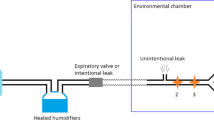Abstract
Introduction
This study compared the heat loss observed with the use of MR860 AEA Humidifier™ system (Fisher & Paykel Healthcare, New Zealand), which humidifies and heats the insufflated CO2, and the use of the AeronebPro™ device (Aerogen, Ireland), which humidifies but does not heat the insufflated CO2.
Methods
With institutional approval, 16 experiments were conducted in 4 pigs. Each animal, acting as its own control, was studied at 8-day intervals in randomized sequence with the following four conditions: (1) control (C) no pneumoperitoneum; (2) standard (S) insufflation with nonhumidified, nonheated CO2; (3) Aeroneb™ (A): insufflation with humidified, nonheated CO2; and (4) MR860 AEA humidifier™ (MR): insufflation with humidified and heated CO2.
Results
The measured heat loss after 720L CO2 insufflation during the 4 h was 1.03 ± 0.75 °C (mean ± SEM) in group C; 3.63 ± 0.31 °C in group S; 3.03 ± 0.39 °C in group A; and 1.98 ± 0.09 °C in group MR. The ANOVA showed a significant difference with time (p = 0.0001) and with the insufflation technique (p = 0.024). Heat loss in group C was less than in group S after 60 min (p = 0.03), less than in group A after 70 min (p = 0.03), and less than in group MR after 150 min (p = 0.03). The heat loss in group MR was less than in group S after 50 min (p = 0.04) and less than in group A after 70 min (p = 0.02). After 160 min, the heat loss in group S was greater than in group A (p = 0.03).
Discussion
As far as heat loss is concerned, for laparoscopic procedures of less than 60 min, there is no benefit of using any humidification with or without heating. However, for procedures greater than 60 min, use of heating along with humidification, is superior.

Similar content being viewed by others
References
Sessler DI (2009) New surgical thermal management guidelines. Lancet 374(9695):1049–1050
Birch DW, Manouchehri N, Shi X, Hadi G, Karmali S (2011) Heated CO2 with or without humidification for minimally invasive abdominal surgery. Cochrane Database Syst Rev (1):CD007821
Sessler DI (2009) Thermoregulatory defense mechanisms. Crit Care Med 37(7 Suppl):S203–S210
Bessell JR, Karatassas A, Patterson JR, Jamieson GG, Maddern GJ (1995) Hypothermia induced by laparoscopic insufflation. A randomized study in a pig model. Surg Endosc 9(7):791–796
Schlotterbeck H, Greib N, Dow WA, Schaeffer R, Geny B, Diemunsch PA. Changes in core temperature during peritoneal insufflation: comparison of two CO2 humidification devices in pigs. J Surg Res [Internet] 2010 Nov 12. http://www.ncbi.nlm.nih.gov/pubmed/21074786. Accessed 29 Aug 2011
Sammour T, Kahokehr A, Hill AG (2010) Independent testing of the Fisher & Paykel Healthcare MR860 Laparoscopic Humidification System. Minim Invasive Ther Allied Technol 19(4):219–223
Ott DE, Reich H, Love B, McCorvey R, Toledo A, Liu CY et al (1998) Reduction of laparoscopic-induced hypothermia, postoperative pain and recovery room length of stay by pre-conditioning gas with the Insuflow device: a prospective randomized controlled multi-center study. JSLS 2(4):321–329
Schlotterbeck H, Schaeffer R, Dow WA, Diemunsch P (2008) Cold nebulization used to prevent heat loss during laparoscopic surgery: an experimental study in pigs. Surg Endosc 22(12):2616–2620
Greib N, Schlotterbeck H, Dow WA, Joshi GP, Geny B, Diemunsch PA (2008) An evaluation of gas humidifying devices as a means of intraperitoneal local anesthetic administration for laparoscopic surgery. Anesth Analg 107(2):549–551
Davis P, Parbrook G (1995) Basic physics ans measurement in anaesthesia. Butterworth-Heinemann, Oxford, pp 125–133
Manwaring JM, Readman E, Maher PJ (2008) The effect of heated humidified carbon dioxide on postoperative pain, core temperature, and recovery times in patients having laparoscopic surgery: a randomized controlled trial. J Minim Invasive Gynecol 15(2):161–165
Mouton WG, Bessell JR, Pfitzner J, Dymock RB, Brealey J, Maddern GJ (1999) A randomized controlled trial to determine the effects of humidified carbon dioxide insufflation during thoracoscopy. Surg Endosc 13(4):382–385
Champion JK, Williams M (2006) Prospective randomized trial of heated humidified versus cold dry carbon dioxide insufflation during laparoscopic gastric bypass. Surg Obes Relat Dis 2(4):445–449 discussion 449–50
Farley DR, Greenlee SM, Larson DR, Harrington JR (2004) Double-blind, prospective, randomized study of warmed, humidified carbon dioxide insufflation vs standard carbon dioxide for patients undergoing laparoscopic cholecystectomy. Arch Surg 139(7):739–743 discussion 743–4
Savel RH, Balasubramanya S, Lasheen S, Gaprindashvili T, Arabov E, Fazylov RM et al (2005) Beneficial effects of humidified, warmed carbon dioxide insufflation during laparoscopic bariatric surgery: a randomized clinical trial. Obes Surg 15(1):64–69
Sessler DI (2000) Perioperative heat balance. Anesthesiology 92(2):578–596
Frank SM, Fleisher LA, Breslow MJ, Higgins MS, Olson KF, Kelly S et al (1997) Perioperative maintenance of normothermia reduces the incidence of morbid cardiac events. A randomized clinical trial. JAMA 277(14):1127–1134
Kurz A, Sessler DI, Lenhardt R (1996) Perioperative normothermia to reduce the incidence of surgical-wound infection and shorten hospitalization. Study of Wound Infection and Temperature Group. N Engl J Med 334(19):1209–1215
Lenhardt R, Marker E, Goll V, Tschernich H, Kurz A, Sessler DI et al (1997) Mild intraoperative hypothermia prolongs postanesthetic recovery. Anesthesiology 87(6):1318–1323
Disclosures
The MR 860 sets were provided for free by Fisher & Paykel® for this study.
Author information
Authors and Affiliations
Corresponding author
Rights and permissions
About this article
Cite this article
Noll, E., Schaeffer, R., Joshi, G. et al. Heat loss during carbon dioxide insufflation: comparison of a nebulization based humidification device with a humidification and heating system. Surg Endosc 26, 3622–3625 (2012). https://doi.org/10.1007/s00464-012-2385-2
Received:
Accepted:
Published:
Issue Date:
DOI: https://doi.org/10.1007/s00464-012-2385-2




